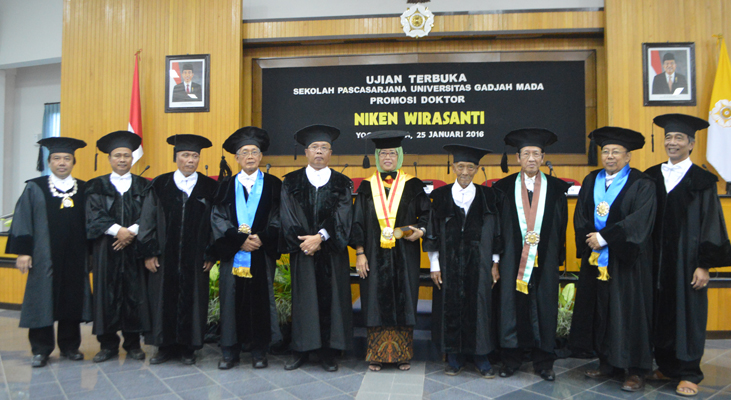
Temples and environment as cultural products of 9th and 10th century society, the era of old Mataram Kingdom, are arranged as a depiction of a sacred room of cosmic symbol. As a sacred room, the cosmic depiction is shown through the temple environment that is fertile soil, near water source as well as building materials.
“The temple courtyard spatial arrangement is embodied in steps with temple expression present the Mt. Meru as a symbol of of cosmic centre,” said Archaeology lecturer from Faculty of Cultural Sciences of UGM, Dra. Niken Wirasanti, M.Si., on Monday (25/1) when being examined for her doctorate at the UGM Graduate School.
Niken said that to realise the temple and environment as cosmic symbol they use same signs that show good order. For instance, the courtyard spatial design of Hindhu or Budha temples are in the form of steps with the central yard being on the top. Temple architecture describe three levels of the world divided into foot (kamadatu), body (rupadatu), and roof (arupadatu).
Niken said,however, that the same sign for temple environment can be interpreted variedly by society of that time as proven by the inscription and literary texts. Despite the same signs, temple and environment have different expression and context.
“Temple and environment expression of each indicate different meaningful messages,” she said, defending dissertation titled Temple Environment of the 9th and 10th Century during the Era of Old Mataram Kingdom in South Kedu -Prambanan”.
Her research showed the temples in South Kedu-Prambanan: Mendut, Pawon, and Borobudur Temples, there are signs system formed in one entity that symbolises the cosmo. This is shown in a series of structured signs. These three are aligned in one imaginary line that describes the Budha Mahayana teaching.
Niken revealed the structural natures can be tracked down from the linear signs that form the three unity depicting the ritual Buddhist journey to perfection in Budha Mahayana teaching. The journey starts from Mendut (sambaramarga) to Pawon (prayogamarga) and ends up at Borobudur Temple, stepping up to the highest top (darsanamarga, bhavanamarga, asaikamarga).
Conotatively, the ground is interpreted as a worldly environment (laukika), as a worship place to the end of ritual goal, The higher ground of Borobudur than Mendut and Pawon conotatively showed Borobudur as a symbol over the world (lokattara). This showed the ritual orientation is centred on Borobudur. The end of spiritual journey is perfection in gaining knowledge based on wisdom, that is good behaviour, words, efforts, and prayers.
“Thus was the hierarchial depiction of the ritual journey meaning gradually from the ground to the top leading to the cosmic centre,” said Niken.


